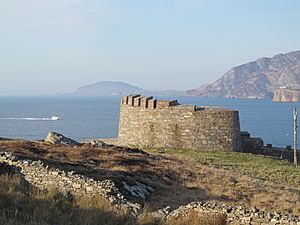Knockalla Fort facts for kids
Quick facts for kids Knockalla Fort |
|
|---|---|
| County Donegal Ireland |
|

Battery tower
|
|

Wall and moat
|
|
| Coordinates | 55°10′49″N 7°34′26″W / 55.1802°N 7.5739°W |
| Site information | |
| Owner | Privately owned |
| Open to the public |
No access |
| Condition | Intact |
| Site history | |
| Built | 1812-1813 |
| Materials | Stone |
| Garrison information | |
| Garrison | British Armed Forces |
Knockalla Fort is an old military fort located in County Donegal, Ireland. It was built a long time ago, between 1812 and 1813. This fort was one of several "Napoleonic batteries." These were special forts built along the coast of Lough Swilly. Their main job was to protect the northwest part of Ireland from a possible French invasion.
The fort was part of a bigger plan to make Lough Swilly and Lough Foyle safe. This was during a time of big wars called the Napoleonic Wars. On the other side of the Lough, you can find another fort called Fort Dunree. Knockalla Fort was actually built on the spot where a temporary fort stood in 1798.
Contents
What Does Knockalla Fort Look Like?
Knockalla Fort has a special triangular shape. At the point of the triangle that faces the land, there is a tall tower. From this tower, two strong walls stretch down towards the steep, rocky cliffs.
Fort Defenses and Levels
These walls were protected by a dry moat. A moat is a deep ditch, and this one was partly cut right into the rock. At the edge of the cliffs, the fort had two levels of "batteries." Batteries are places where cannons are set up.
Lower Battery
The lower battery had seven places for cannons. These cannons were very large, called French 42 Pounder smooth bore guns. They were placed on "traversing platforms," which helped them turn to aim.
Upper Level
The upper level of the fort had several important areas. It included places for soldiers to sleep, called barrack accommodation. There was also a "magazine," which is a safe place to store gunpowder and ammunition. "Casemates" were strong, protected rooms, often used for defense or storage. This level also had the main entrance gate. On the northern side of this upper level, there was another battery with two 24 Pounder smooth bore guns.
The Tower's Role
The tower itself was shaped like a quarter circle with rounded corners. It was also armed with its own weapons. These included a 24 Pounder gun and a 5.5-inch "howitzer." A howitzer is a type of cannon that can fire shells in a high arc.
History of Knockalla Fort
After the Napoleonic Wars ended, the need for these forts decreased. Because of this, the defenses at Knockalla Fort were not kept up to date. They were also not improved with newer technology.
Fort Becomes Obsolete
By the 1860s, the fort still had some weapons. The tower had an 18 Pounder gun and a 5.5-inch howitzer. The upper battery had a 24 Pounder gun. However, by this time, the fort was considered "obsolete." This means its design and weapons were old-fashioned and no longer effective against modern threats.
Abandonment and Current Use
Because it was no longer useful for military purposes, the fort was "disarmed." This means its weapons were removed. The military then abandoned the fort in the 1870s. Today, Knockalla Fort is still mostly intact. It is now used as a private home.

